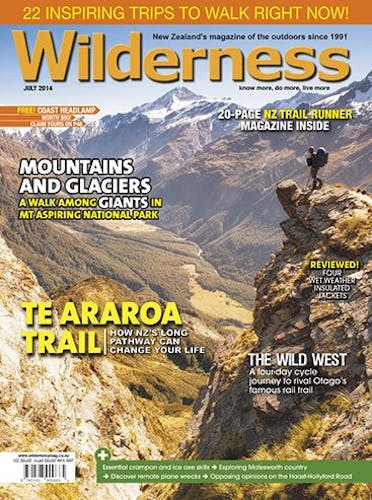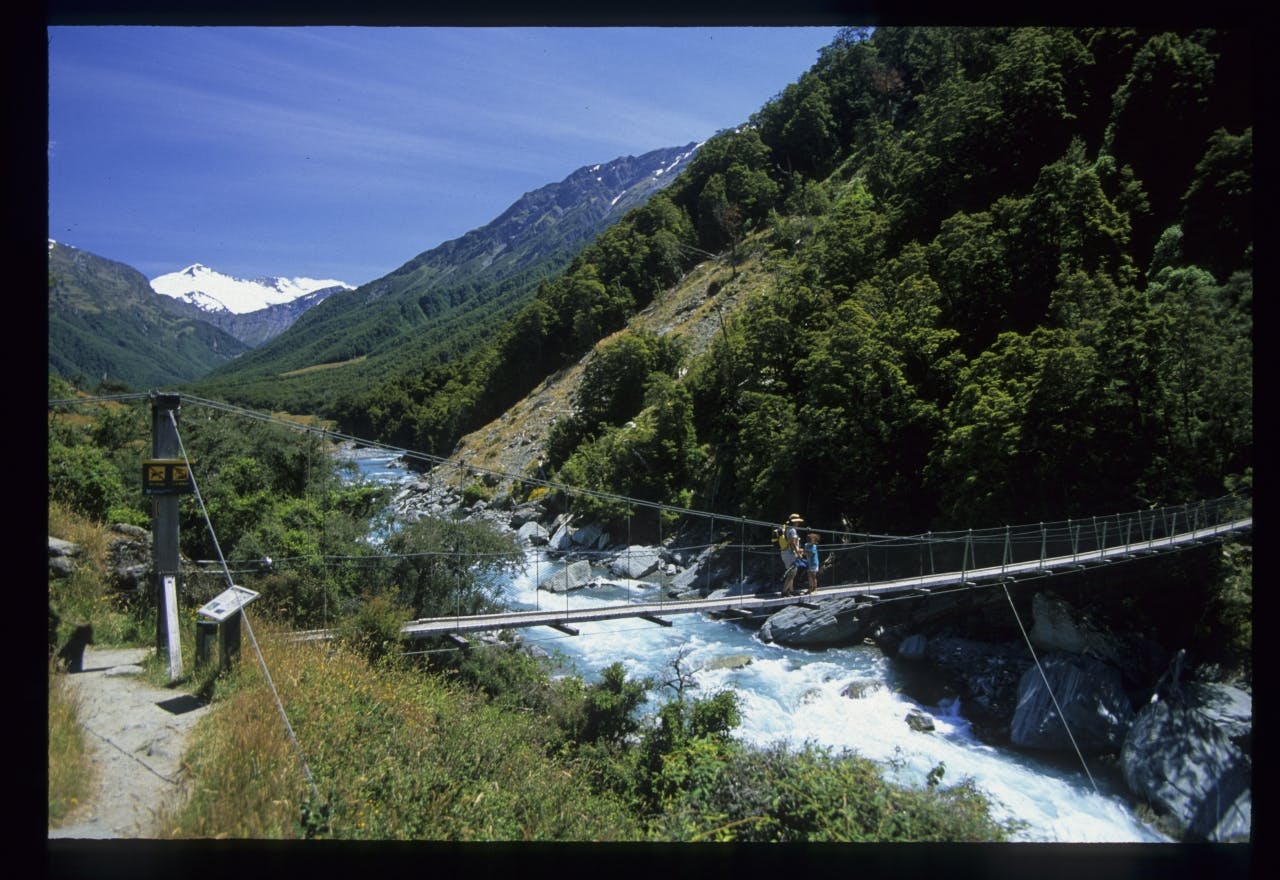Is the urban-rural divide putting landowners off allowing trampers to roam their land? Matthew Pike discovers not all farmers think trampers are more trouble than they’re worth
A tramper’s eye doesn’t discriminate. If we see a mean looking range or a path to a secluded beach, we’re not fussed whether it’s on the public estate or private farmland – we just have an overwhelming desire to tread it.
And why not?
For the most part, we’re a friendly bunch. And after all, we’re only there to ‘walk’. We’re not there to shoot wildlife, wheel-spin in the mud, peer into windows or cuddle sheep. If we’re not spotted, no-one would even know we were there.
So why would many landowners prefer trampers to stay away?
Anders Crofoot, of the Federated Farmers of New Zealand, says there are a number of issues which those not familiar with the day-to-day working of a farm may be unaware of.
Crofoot, who runs Castlepoint Station in the Wairarapa, says even someone’s mere presence can create problems: “A ewe might run away when they see someone. If it has twin lambs, the ewe may take one lamb and leave the other. It would have been through no fault of the person walking through, just merely their presence that caused the problem.
“You may also get a large mob of sheep, they may all pile into a corner when they see someone, expecting feeding, which can lead to some getting smothered.”
Crofoot compares a farm to a factory floor: “You wouldn’t dream of walking across a factory floor, and a farm may look like open space, but the reality is it’s a place of work and things happen that you might not be aware of.”
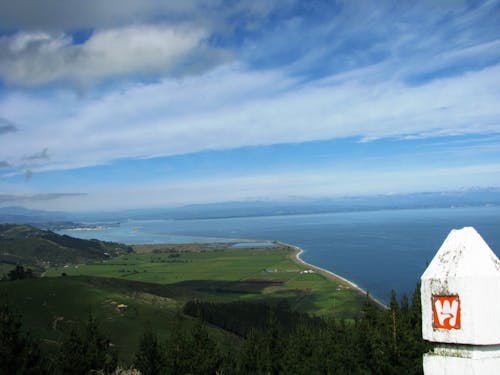 He adds that most farmers will let you cross their land if you ask them and he also allows access to his land if it’s part of a longer journey, such as a long distance walk for charity or a multi-day challenge. Walkers attempting the private Whareama Coastal Walk do, in fact, head across part of Crofoot’s land. But he doesn’t allow people to cross just for a day walk. There are, he says, plenty of other places to go for a ramble.
He adds that most farmers will let you cross their land if you ask them and he also allows access to his land if it’s part of a longer journey, such as a long distance walk for charity or a multi-day challenge. Walkers attempting the private Whareama Coastal Walk do, in fact, head across part of Crofoot’s land. But he doesn’t allow people to cross just for a day walk. There are, he says, plenty of other places to go for a ramble.
The urban-rural divide is an issue echoed by Barbara Stuart. She and her husband Ian run Cable Bay Farm, just north of Nelson. The family have always encouraged walkers to access their land and, in the early 1980s, opened Cable Bay Walkway, which bisects the farm. For walkers, it’s a great three-hour tramp that can be turned into a full day’s walk by returning the same way or via the coast at low tide. It offers lovely views over Tasman Bay and Cable Bay, the latter being historically significant as the place where a communication cable connected New Zealand to the rest of the world.
Barbara says any problems they face tend to be with those who don’t understand how a farm operates.
“Not long ago we had a cow which Ian took off the hill because it had a limp. He wanted to see if it would heal or if the cow had a broken bone. Someone saw the limping cow and reported it to the SPCA.
“Often people don’t realise that this is the reality of the industry. It’s a tough business – you’ve got to do it well – it’s not a holiday farm for the animals. There’s always been that urban-rural divide.”
But Barbara says these instances are rare and that the pros of allowing walker access have far outweighed the cons.
“Opening up the track meant the phone would stop ringing!” she jokes. “There were already people doing the walk before it became official; my parents-in-law were traditional farming folk who welcomed visitors and enjoyed sharing the bush walk and scenery with others. People always visited and camped here.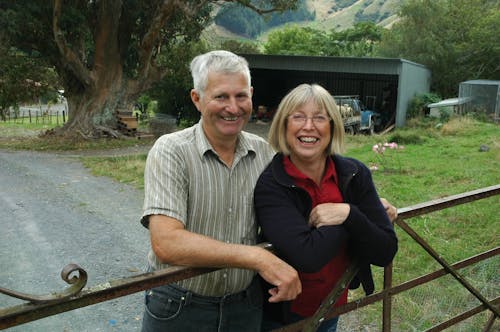
“We had a party line in those days and lots of people would phone us on a Friday night to ask permission to walk the track. We had young children who would sometimes wake up from the phone ringing. We had a family talk and thought the walkway was a good idea.”
The Stuarts found the long-term benefits of the track extended well beyond ending the Friday night phone calls. When their sheep farming operation struggled they were able to supplement earnings by setting up a campsite at the Cable Bay end of the walkway, then build a cafe next door. Both are still open.
But does letting walkers roam your land day after day have its problems?
“We’re fortunate to have never experienced any real issues and we’ve found the public is our friend, not our foe,” says Barbara. “People will tell us if stock is in trouble.
“But it depends on your situation. People with flatter land than ours can have problems with members of the public getting up to mischief. But people are very good at putting others right – most walkers, if they see someone doing something they shouldn’t, let you know.”
Barbara believes one of the reasons fewer people are willing to give access these days is because they’re nervous about regulation. The Walking Access Commission has tried to combat this by clarifying exactly what the rights and responsibilities are of both landowner and tramper.
If they don’t know you’re on their land, the landowner is not responsible for anything that happens to you (not that you should be on private land without asking). If they do know you’re there, they’re only responsible if you fall victim to a hazard that you wouldn’t expect to see on a farm, such as a large, recently dug hole, or a falling tree. And, even then, if they’ve warned you about it, or the incident takes place at a different spot to which you said you were going, the farmer would have no legal issues.
But, says Anders Crofoot, accidents can still lead to problems. “Allowing access can lead to unexpected consequences – if all goes well there’s no issue, but when there’s an accident things are not so simple, and can lead to lengthy chats with ACC, the police and so on.
“Also, if a tramper leaves a gate open and stock run on to the road, the farmer has to prove they (the farmer) weren’t negligent, which is a difficult thing to do.”
The Harwood family, in Upper Takaka, Golden Bay, have adopted a near open-door policy on their farm and have suffered very few of the issues other farmers fear.
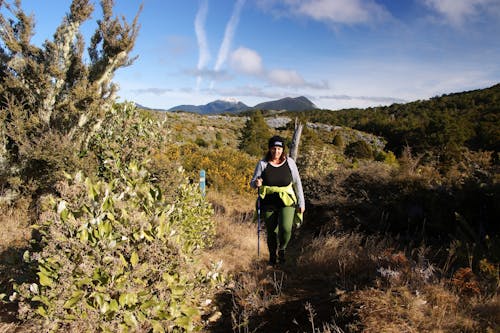 The land at the top of Takaka Hill is a fascinating karst landscape with deep cave systems and jagged limestone rocks jutting from the surface. The family has always been keen to protect it; David Harwood, who used to run the farm – Kahurangi Station – remembers his late father saying “it’s a shame there’s no access to it”.
The land at the top of Takaka Hill is a fascinating karst landscape with deep cave systems and jagged limestone rocks jutting from the surface. The family has always been keen to protect it; David Harwood, who used to run the farm – Kahurangi Station – remembers his late father saying “it’s a shame there’s no access to it”.
David says the family dream that the public could access it for themselves was realised in 1997 when they opened the Takaka Hill Walkway – a track that takes walkers across the karst landscape at the top of the hill.
“The late Martin Conway, from DOC, organised fundraising to pay someone to put the track in,” says David. “This produced a medium for people to see it. When Martin said that hundreds of people will walk the track, I thought ‘what a dreamer’, but he was right. It gets a lot of use which, for us, is very gratifying to see.”
Like the Stuarts, the Harwoods have had little fuss from allowing tramper access, or from the cavers, hang gliders, pig hunters, deer shooters, horse riders or school groups to whom they also allow access. David thinks it’s a shame when others don’t wish to share their property with the public.
“Some people consider their land to be their castle.” And while he admits to encountering the odd problem with walkers, he says patience saves the day: “Some landowners are unprepared to put up with fall-outs, but it pays not to get carried away. You have to say ‘that guy is an idiot, but 5000 other people have treated the place with respect’. There are problems, but they’re not worth dwelling on.”
However, Nigel Harwood, David’s son who now runs the farm with the same open access culture as his father, says it’s important that farmers have the power to restrict access when necessary.
“Some people want the right to roam but that makes me nervous; I rely completely on what I get off the land and the ability to control access is important even though I’ve found I can be pretty liberal with it.”
Further south, and many trampers will find the Aspinall name familiar, especially those who have headed from Wanaka towards the likes of Rob Roy Glacier, Cascade Saddle, French Ridge Hut and Mt Aspiring.
On each occasion they’ll have walked through Mt Aspiring Station, across land on which the Aspinalls have aided access since they moved there in the 1920s.
“The family as a whole have always loved the outdoors,” says Allison Aspinall. “We realise it’s a beautiful part of the country, we feel privileged to live here and we shouldn’t exclude others from enjoying this amazing scenery.
“We haven’t had any major problems. The odd person leaves a gate open, which means we have to move stock back but, considering the number of people who come here, it’s very infrequent.
“Some tourists don’t understand how to cope with stock on the road. They might stand in the road to take photos, or wave their arms or toot their horn, which can be a bit annoying.
“But it’s nice to see people enjoying the place. When you live in a remote place it’s good to see people and in some ways it’s good for the stock because they become used to seeing people which keeps them calm and quiet.”
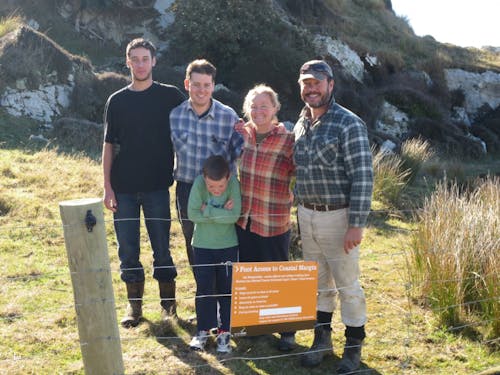 The South Island farmers mentioned so far have all had long, family associations with their areas. But Michael Hurley and Beatrice Lassere, who own a small coastal farm near Milton, Otago, only arrived at the property seven years ago.
The South Island farmers mentioned so far have all had long, family associations with their areas. But Michael Hurley and Beatrice Lassere, who own a small coastal farm near Milton, Otago, only arrived at the property seven years ago.
Having worked on farms overseas they were surprised to see people walking over their land when they first arrived in New Zealand. A coastal track already existed, where walkers needed to cross paddocks at the edge of the property to traverse cliffs. The rugged coastline is popular with locals who often head to the seal colony at Quoin Point, just north of the property.
Michael and Beatrice enjoyed seeing people there and decided to make coastal access easier by formally opening a two-kilometre track across their land from the end of Russell Rd to the sea.
The new signposted track also meant they no longer had to answer the door and explain ground rules to scores of people asking permission to cross their land.
“Getting signposts made it more formal and channelled people along a certain route which was convenient for the farm,” says Beatrice. “Rather than sending people across the farm, they follow the fence line which means fewer disturbances for the sheep.
“It’s helped us meet a lot of the locals and people seem very happy to be allowed to walk on the farm.
“One reason we’re keen to encourage it is because many people don’t know what goes on at farms anymore. If you keep people off the land, the only information they have access to is in the press, which is not very positive. When I watch TV I often see a lot of nonsense.”
The only major issue the couple have found is that dogs not treated for taenia ovis (sheep measles) spread the parasite to sheep, ruining their carcasses. They are considering banning dogs from their land, but the last thing they want to do is prevent human access. In fact, they have plans to extend it further.
“Long term, we have gullies running from road to coast and we’d like to fence these off and have another walk through native bush down to the coast,” says Beatrice.
“The financial effort is the fencing, but after that it doesn’t really cost anything to let people walk on your farm. It seems obvious to us – why wouldn’t we let people get something out of it?
Many farmers who now allow access have received support from the Walking Access Commission. And most sing the commission’s praises in the clarity they’ve given over walker and farmer rights and responsibilities.
Farmers who were nervous about allowing public access are now more comfortable to do so because they know when they are and aren’t responsible for people on their land.
This is great news for trampers who may see more tracks opening across private land in the coming years. But don’t hold your breath because access will always depend on the good nature of the landowner. They have to derive some form of pleasure or advantage from people enjoying their land. And this has to override any perceived risks or problems.
And for as long as some people report limping cows or leave gates open, walkers will always be perceived by some as a risk and the urban/rural divide will never close. But perhaps if more landowners are aware of the economic benefits experienced by the Stuarts, the social benefits experienced by Beatrice and Michael in Otago, and the sheer joy the Harwoods and Aspinalls feel by seeing people enjoying the land, walkers may yet be able to twist a few arms.
Private land and paper roads – what are our rights?
Under normal circumstances, you’re at the mercy of the landowner as to whether you can walk on their land or not. If they say ‘no’ then you have no legal right to be there.
This rule applies whether it’s farmland, private forest or Maori land.
However, all over the country there are ‘unformed legal roads’ – better known as paper roads – many of which cross private land.
If this is the case, legally you can walk that route whether an actual path exists there or not. If you stray from the path, you’re trespassing, so good navigation skills are required.
The Walking Access Commission (WAC) has colour coded mapping, marking the likes of conservation land, accessible hydro areas and, of course, paper roads.
However, the commission strongly recommends you notify the landowner before treading on their land, even if you have a legal right to be there. As highlighted in the feature, there are certain circumstances in which a farmer may wish you to avoid a certain area and they may even point out a better route to your destination.
To access WAC’s mapping system visit wams.org.nz
Five ways to keep the farmer happy
- Tell them your intentions: You never know what issues may arise from you being there. Even if you have a legal right to be there, it’s best (and polite) to let them know your plans
- Respect the workplace: If farmers feel your presence may, say, risk separating lambs from their mothers, respect their requests to avoid an area or to take a different route
- Close all gates: This might sound obvious, but the Aspinalls say big groups of trampers sometimes leave gates open when the person at the back doesn’t realise it was closed to start with. It can take a farmer half a day to move stock back into the right field
- Report dead / injured animals: Tell the farmer if you see a problem. Don’t bypass them to inform an authority – this really irritates them
- Treat your pets: If dogs are also allowed, make sure they’re treated for conditions that may spread to livestock, such as the taenia ovis parasite experienced on Beatrice and Michael’s farm.





